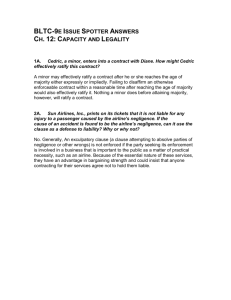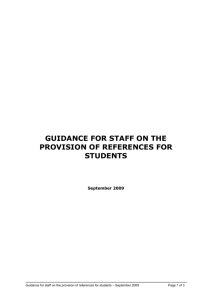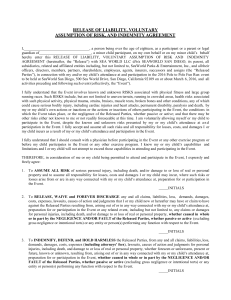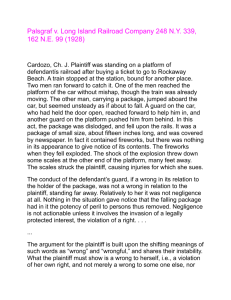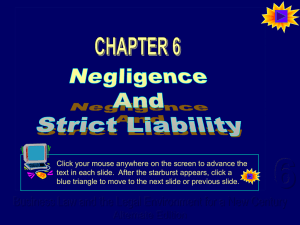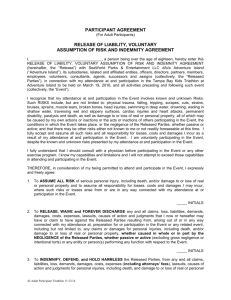St Brendan's Sixth Form College
advertisement
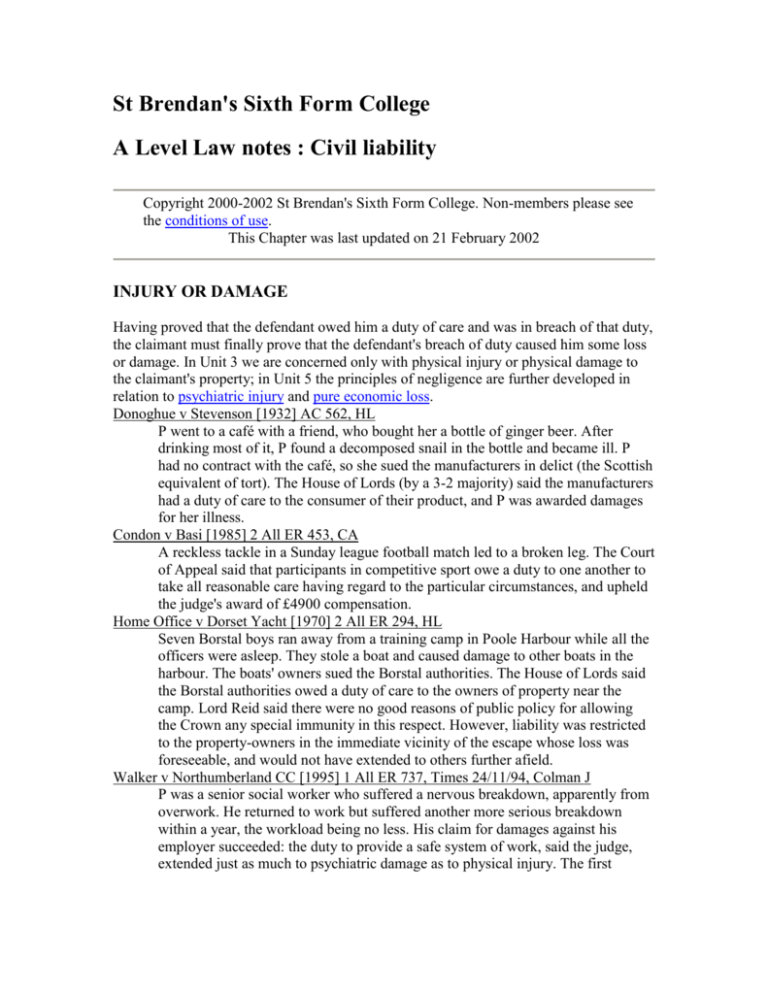
St Brendan's Sixth Form College A Level Law notes : Civil liability Copyright 2000-2002 St Brendan's Sixth Form College. Non-members please see the conditions of use. This Chapter was last updated on 21 February 2002 INJURY OR DAMAGE Having proved that the defendant owed him a duty of care and was in breach of that duty, the claimant must finally prove that the defendant's breach of duty caused him some loss or damage. In Unit 3 we are concerned only with physical injury or physical damage to the claimant's property; in Unit 5 the principles of negligence are further developed in relation to psychiatric injury and pure economic loss. Donoghue v Stevenson [1932] AC 562, HL P went to a café with a friend, who bought her a bottle of ginger beer. After drinking most of it, P found a decomposed snail in the bottle and became ill. P had no contract with the café, so she sued the manufacturers in delict (the Scottish equivalent of tort). The House of Lords (by a 3-2 majority) said the manufacturers had a duty of care to the consumer of their product, and P was awarded damages for her illness. Condon v Basi [1985] 2 All ER 453, CA A reckless tackle in a Sunday league football match led to a broken leg. The Court of Appeal said that participants in competitive sport owe a duty to one another to take all reasonable care having regard to the particular circumstances, and upheld the judge's award of £4900 compensation. Home Office v Dorset Yacht [1970] 2 All ER 294, HL Seven Borstal boys ran away from a training camp in Poole Harbour while all the officers were asleep. They stole a boat and caused damage to other boats in the harbour. The boats' owners sued the Borstal authorities. The House of Lords said the Borstal authorities owed a duty of care to the owners of property near the camp. Lord Reid said there were no good reasons of public policy for allowing the Crown any special immunity in this respect. However, liability was restricted to the property-owners in the immediate vicinity of the escape whose loss was foreseeable, and would not have extended to others further afield. Walker v Northumberland CC [1995] 1 All ER 737, Times 24/11/94, Colman J P was a senior social worker who suffered a nervous breakdown, apparently from overwork. He returned to work but suffered another more serious breakdown within a year, the workload being no less. His claim for damages against his employer succeeded: the duty to provide a safe system of work, said the judge, extended just as much to psychiatric damage as to physical injury. The first breakdown may not have been foreseeable, but the second certainly was, and DD had taken manifestly inadequate measures to protect P's health. Reilly v Merseyside HA (1995) 6 Med LR 246, CA Elderly visitors PP suffering from angina and claustrophobia respectively were stuck for over an hour in a hospital lift that jammed because of negligent maintenance. Allowing DD's appeal, the Court of Appeal said PP's worry about one another, and even panic, were normal human emotions in the face of a most unpleasant experience. They were not recognisable psychiatric injuries, so the claim must fail. McFarlane v Tayside Health Board (1999) Times 26/11/99, HL P1 underwent a vasectomy, but he and his wife P2 subsequently conceived and gave birth to a child C. In preliminary proceedings, the House of Lords said P2 was entitled in principle to claim for the pain and discomfort of giving birth, but the birth and subsequent upbringing of a normal healthy child could not amount to damage giving a right to compensation. The birth of a child is a mixed blessing conferring both benefits and burdens on its parents, said Lord Millett, but society takes the view that the benefits outweigh the burdens, and the parents cannot make it actionable by saying (however truthfully) that it was a blessing they did not want. Rees v Darlington Hospital (2002) Times 20/2/02, CA A woman C suffering from hereditary blindness sought sterilisation; the operation was negligently performed and she subsequently bore a son. The Court of Appeal (Waller LJ dissenting) distinguished McFarlane and other cases and said she should receive damages for the additional costs she would incur (as a disabled parent) in bringing up a child. Hale LJ said that where the "incalculable benefit" of a child is put at risk by the very fact that caused the claimant to seek sterilisation, it was not unjust or unreasonable to hold the surgeon answerable for the consequences of his negligence. White v Jones [1995] 1 All ER 691, Times 17/2/95, HL A solicitor was negligent in preparing a client's will; as a result, when the client died his two daughters PP did not receive legacies of £9000 each that he had intended then to have. The House of Lords (affirming the Court of Appeal and reversing the trial judge) found the solicitor liable to the disappointed beneficiaries, and awarded damages accordingly. Spartan Steel v Martin [1972] 3 All ER 557, CA While digging a trench, DD negligently cut off the electricity supply to PP's steelworks. The Court of Appeal allowed PP's claim for the value of the "melt" that was ruined by the power cut, including the profit directly associated with it, but by a majority they denied a claim for loss of profits on four further melts that could have been completed during the period that the supply was cut off. Several reasons were offered for this decision, but the most significant was probably the fear of opening the floodgates to many similar claims should a contractor sever the power supply to a whole estate or even a small town. Merlin v British Nuclear Fuels [1990] 2 QB 557, Gatehouse J PP found radioactive dust in their house in Ravenglass; they sought to move away because of the risk to their children's health, but were unable to sell their house for what they considered a proper price. They sued BNFL under ss.7(1) and 12(1) of the Nuclear Installations Act 1965, but the judge said "damage to property" in the Act meant physical damage to tangible property and did not cover pure economic loss; nor did the increased risk of developing cancer (assuming such a risk existed) amount to physical injury. Factual causation The claimant must show it is more likely than not that had the defendant not been negligent his injury or damage would not have occurred. If the injury would (probably) have happened anyway, or if it was (probably) caused by something other than the defendant's negligence, the claim will inevitably fail. McWilliams v Arrol [1962] 1 All ER 623, HL A steel erector fell 70 feet to his death, and his widow claimed damages against his employers, who had not provided him with a safety belt. Although the firm was in breach of its statutory duty to provide a belt (but not to insist that it be worn), there was evidence to show that the man would probably not have worn a belt even had it been provided, so the firm's negligence and breach of statutory duty were not the cause of his death. Barnett v Chelsea & Kensington Hospital [1968] 1 All ER 1068, Nield J A man went to a hospital complaining of stomach pains and vomiting. The doctor refused to examine him and sent him home untreated, and he died of arsenic poisoning five hours later. His family sued the hospital but failed. The medical evidence was that he would probably have died even if the proper treatment had been given promptly, so the hospital's negligence was not the cause of his death. McGhee v National Coal Board [1972] 3 All ER 1008, HL A mine worker contracted dermatitis, and sued the Board. It was found as a fact that the Board were negligent in not providing adequate washing facilities for their staff, and that they were liable even though P could not prove that his dermatitis was caused directly by the lack of washing. It was sufficient, said the House of Lords, that the Board's negligence substantially increased the risk of P's contracting the disease. This decision is at odds with the others considered here, and commentators have suggested that the courts' more generous attitude towards the plaintiff applies only in industrial injuries, not in medical negligence. Kay v Ayrshire Health Board [1987] 2 All ER 417, HL A boy P was negligently given an overdose of penicillin while being treated for meningitis, and subsequently went deaf. There was no evidence to show that deafness had ever been caused by penicillin, but it was said to be a common aftereffect of meningitis. P's claim for damages therefore failed: the House of Lords said it could not presume in P's favour that the tortious act was the cause of his injuries unless it was proved that such an act was at least capable of causing or aggravating the damage. Hotson v East Berkshire Health Authority [1987] 2 All ER 909, HL A boy P injured his hip by falling out of a tree. He was taken to hospital, where the injury was wrongly diagnosed and he was thus given inappropriate treatment. He suffered a permanent disability and sued; the hospital admitted negligence but denied liability. The trial judge found as a matter of fact that had the injury been correctly diagnosed and treated P's chance of recovery would have been 25%, and consequently awarded 25% of the appropriate damages. This judgement was reversed by the House of Lords, who said P had not proved on a balance of probabilities that the negligent treatment had caused his disability - on the contrary, the probabilities were 75-25 that it had not. P therefore had no claim whatever. [Had the judge put the lost chance of recovery at (say) 60%, P would have been entitled to full damages.] Wilsher v Essex Health Authority [1988] 1 All ER 871, HL A premature baby P was negligently given excess oxygen; it was subsequently found that he had developed an incurable eye condition. P's claim against the hospital failed; his blindness could have been caused by any of half a dozen factors, of which the hospital's admitted negligence was just one. The combination of negligence and injury did not in itself create a presumption of causation, and a dictum of Lord Wilberforce to this effect in McGhee was expressly disapproved. It was not for D to show an alternative cause but for P to show (on a balance of probabilities) that the negligence had caused the damage, or had at least materially contributed to it, and this he could not do. Holtby v Brigham & Cowan [2000] 3 All ER 421, CA A man C suffered asbestosis as a result of breathing asbestos dust at work over a long period; for about half that time he was employed by DD, and for the rest by other employers doing similar work. The Court of Appeal upheld the judge's ruling that C had to prove that DD's negligence had made a material contribution to his disability, and that even then DD were liable not for the whole of the disability but only for that part which they had caused. (The judge applied a common sense approach, erring slightly in C's favour, and put the relevant fraction at 75 per cent.) Fairchild v Glenhaven (2001) Times 13/12/01, CA In conjoined appeals covering a number of workers who had contracted mesothelioma during a time in which they had worked for more than one employer, the Court of Appeal said no liability atached to any of the employers as the claimants could not prove on the balance of probabilities the period of employment in which they inhaled the asbestos fibre which started the disease. [This is consistent with Holtby v Brigham & Cowan only inasmuch as the claimant in that case had spent (more than) half the relevant time with one employer.] The main exception to this rule arises where P is injured by one of several tortfeasors and cannot prove which one. Fitzgerald v Lane [1988] 2 All ER 961, HL A pedestrian P on a pelican crossing was struck by a car driven without due care, thrown into the path of another car also driven carelessly, and struck by that car too. There was no medical or scientific evidence to show which of the two cars had been the direct cause of P's injuries. The House of Lords (while disagreeing as to the assessment of damages) upheld the trial judge's decision that the two drivers should be jointly liable. Several American cases have gone the same way: in Oliver v Miles (1926) a boy was accidentally shot by one of two hunters each of whom had fired negligently, and the Mississippi courts awarded damages against them jointly. We think each is responsible, said the judge, for the resulting injury to the boy, although no one can say definitely who shot him. To hold otherwise would be to exonerate both from liability, although each was negligent and the injury resulted from such negligence. When we consider the relative position of the parties, said a Californian judge in the similar case of Summers v Tice (1948), and the results that would flow if P was required to pin the injury on one of the defendants only, a requirement that the burden of proof on that subject be shifted to the defendants is manifest. Foreseeability of damage The law also requires a reasonable foreseeability of the kind of damage actually caused; this is not hard to justify, because even the most reasonable person cannot be expected to guard against a risk that cannot be foreseen. Where damage of a particular kind could not reasonably have been foreseen, it is sometimes said to have been "too remote". Palgraf v Long Island RR (1928) 284 NY 339, USA A railway worker carelessly knocked a box to the ground; unknown to him, it contained fireworks which exploded on impact, and the blast knocked a weighing machine onto P standing some distance away. The court said injury to P was not foreseeable from the mere dropping of a box, and D was not liable for P's injuries. Overseas Tankship v Morts Dock (The Wagon Mound (No 1)) [1961] 1 All ER 404, PC Oil was spilled from a ship, and a fire was caused when sparks from work being done on the wharf ignited the oil. The fire caused extensive damage to the wharf and dockside buildings, and the owners of the dockyard sued the shipowners. The Privy Council said that if some damage - even minor damage - of a particular kind was foreseeable, then D would be liable for all such damage irrespective of the foreseeability of its extent and its immediate cause. Here, however, the evidence was that the risk of fire could not have been foreseen, but only a risk of pollution the plaintiffs were loth to admit the foreseeability of the fire risk because it was their workmen who actually set the oil alight - so the shipowners were not liable. Hughes v Lord Advocate [1963] 1 All ER 705, HL(S) On a winter evening some Post Office workmen took a break, leaving an manhole covered by a small tent with a paraffin lamp at each corner. Two boys aged 8 and 10 took one of these lamps and went into the tent; one of them tripped, and the lamp fell into the manhole where it caused an explosion in which the boy was injured. Reversing the Court of Session, the House of Lords said the Post Office were liable: the accident was caused by a known source of danger and that made it forseeable even though the way in which it happened was unexpected. Doughty v Turner Manfacturing [1964] 1 All ER 98, CA A workman P was burned when another worker knocked a cement block into a cauldron of molten liquid; the block slid gently into the liquid, but a chemical reaction caused a violent eruption a minute or so later. The trial judge found as fact that the state of scientific knowledge was such that the chemical reaction could not have been foreseen, but that DD knew knocking things into the liquid might cause a dangerous splash; he therefore awarded damages. Allowing DD's appeal and distinguishing Hughes, the Court of Appeal said the accident was of a wholly different sort from that which could have been foreseen, rather than a foreseeable source of danger causing injury in an unexpected way. Overseas Tankship v Miller Steamship (The Wagon Mound (No 2)) [1966] 2 All ER 709, PC The facts are stated above. A second action was brought by the owners of other ships damaged in the fire, and evidence was given that the risk of fire was foreseeable, though admittedly very small. This time PP were successful, because the potential consequences of that unlikely occurrence were so serious as to give rise to a duty of care to avoid it. Margereson v Roberts [1996] PIQR P358, CA As children in the 1930s, PP played in and around DD's asbestos factory, where asbestos dust was widespread; they subsequently developed the lung disease mesothelioma. DD said mesothelioma was unforseeable prior to research first published in 1960, but PP's claim succeeded. The Court of Appeal said it had been known since the beginning of the century that breathing asbestos dust created a risk of some physical harm, and that was sufficient. It is the kind of damage that must be foreseeable, however, and not its exact nature or extent. If some damage was a foreseeable result of the defendant's negligence, he is liable for all damage of that kind even if it was more serious than anyone could have foreseen. Bradford v Robinson Rentals [1967] 1 All ER 267, Rees J In January 1963 P was instructed by his employer to take an old van from Exeter to Bedford (about 250 miles each way) so that it could be replaced by a new one; the weather was particularly cold and the AA were advising motorists not to travel unless it was necessary. P protested but was again told to go: both vans were unheated, he had to drive with the window open to keep the windscreen clear, and on several occasions he had to get out to remove snowdrifts or top up a faulty radiator. P suffered frostbite and DD were held liable: it was foreseeable in the circumstances that P would suffer some cold-related injury, so they were liable for his frostbite even though that particular condition is very rare in England. Vacwell Engineering v BDH Chemicals [1969] 3 All ER 1681, Rees J DD supplied a chemical liable to explode on contact with water, but failed to warn the recipients of its properties. It did explode and DD were held liable (subject to a 20% deduction for contributory negligence agreed on appeal) for the destruction of a laboratory on the basis that some damage to property (even if only a broken flask) was a foreseeable result of their negligence. In particular, the "eggshell skull" rule ensures that if some personal injury was foreseeable, the defendant is liable for the full extent of the claimant's injuries even if the claimant was particularly susceptible. In Owens v Liverpool Corporation [1938] 4 All ER 727, MacKinnon LJ said that one who is guilty of negligence to another must put up with idiosyncrasies of his victim that increase the likelihood or extent of damage to him; it is no answer to a claim for a fractured skull that its owner had an unusually thin one. A better way of stating the rule is to say that if it is foreseeable that personal injury may result from D's conduct, and if because of some peculiarity in P the injury is more serious than could reasonably have been anticipated, then D is nevertheless liable to P for the full extent of that injury. A negligent defendant must take his victim as he finds him. On the other hand, if no injury at all is reasonably foreseeable to a normal person, D is not in breach of his duty of care. Smith v Leech Brain [1961] 3 All ER 1159, Parker CJ A workman was slightly splashed by molten metal through his employers' negligence and suffered a burn on his face. The burn aggravated a pre-existing cancerous condition and the man died. His widow sued the employers, who were fully liable because "injury to the person" was regarded as a single kind of damage and some minor injury at least was foreseeable. Jobling v Associated Dairies [1981] 2 All ER 752, HL A workman suffered a slipped disc through his employer's negligence, and his earning capacity was reduced by half. Four years later he was found to have a preexisting spinal disease unrelated to his accident, which by the time of the trial had made him totally incapable of work. The employer was held liable for only four years' loss of earnings, this being a rare case in which the "eggshell skull" rule operated to the benefit of the defendant. Robinson v Post Office [1974] 2 All ER 737, CA P slipped on a ladder at work because of oil on the step, and suffered a minor injury. He went to hospital and was given an anti-tetanus injection, as a result of which he contracted encephalitis due to an allergy of which he was previously unaware. DD, as P's employers, were legally responsible for the encephalitis as well as for the minor injury: if a wrongdoer ought to foresee, said Orr LJ, that as a result of his wrongful act the victim may require medical treatment then he is liable for the consequences of the treatment applied even though he could not reasonably foresee those consequences. Novus actus interveniens Problems arise when another event comes between the negligence and the damage; the court must then consider whether there was a nova causa interveniens - a new intervening cause - or whether the ultimate damage was a foreseeable consequence of the original negligence. Three cases must be distinguished: the intervening event may be an act of nature, or an act of a third party, or an act of the plaintiff himself, but the same principles apply to all three. Jones v Boyce (1816) 171 ER 540, Lord Ellenborough CJ D's coach went out of control when a coupling broke and a passenger P, realising the danger, jumped from the coach and sustained a broken leg. In fact the coachman brought the coach safely to a halt. The judge said P's action for damages could proceed and the jury found in his favour: his actions were those of a reasonable man, and the cause of his injury was the dangerous situation created by D's negligence. Philco Radio v Spurling [1949] 2 All ER 882, CA DD delivered to PP's premises five unmarked packing cases containing highly inflammable film scrap. A typist employed by PP, unaware of the danger, approached the cases with a lighted cigarette in her hand, and the resulting explosion and fire caused extensive damage. DD were held liable for the damage as a reasonably foreseeable consequence of their negligence. The majority of the Court of Appeal said if the typist's act in igniting the scrap had been intentional it would have been nova causa interveniens, but this was not shown. Carslogie Steamship v Norway (The Carslogie) [1952] 1 All ER 20, HL PP's ship was damaged through DD's negligence. After temporary repairs the ship set out on a journey that she would not have made had there not been a collision, and suffered further damage in a storm. The House of Lords said this damage was not a consequence of the collision but an ordinary hazard of the sea, and DD were not to be held liable for it. Pigney v Pointers Transport [1957] 2 All ER 807, Pilcher J P, who was already somewhat neurotic, received head injuries in the course of his work, for which his employers were liable. He consequently suffered even greater anxiety, neurosis and depression, and committed suicide eighteen months later. His widow sued under the Fatal Accidents Acts and succeeded. Her loss was a direct and foreseeable result of the accident, the eggshell skull rule applied, and even though suicide was then a crime there was no public policy reason why the widow should not receive damages. Wieland v Cyril Lord Carpets [1969] 3 All ER 1006, Eveleigh J P injured her neck through DD's carelessness and had to wear a cervical collar. This interfered with her wearing her glasses, and she subsequently fell down some steps and suffered further injury. DD were held liable for this further injury: it was foreseeable that one injury might affect a person's ability to cope with the vicissitudes of life and thereby cause another injury. McKew v Holland Hannen & Cubitts [1969] 3 All ER 1621, HL A man whose leg had been weakened in an accident caused by DD's negligence was about to descend a steep staircase with no handrail when he felt it start to give way. He therefore jumped down the remaining steps, injuring his other leg. DD were not liable for this second injury; Lord Reid said that if the injured man acted unreasonably he could not hold the defendant liable for the consequences. Robinson v Post Office [1974] 2 All ER 737, CA P slipped on a ladder at work because of oil on the step, and suffered a minor injury. He went to hospital and was given an anti-tetanus injection, as a result of which he contracted encephalitis due to an allergy of which he was previously unaware. On the facts, the Court of Appeal held that the hospital was negligent but not liable, since even the proper procedure would not have revealed the allergy. P's employers, however, were legally responsible for the encephalitis as well as for the minor injury: if a wrongdoer ought to foresee, said Orr LJ, that as a result of his wrongful act the victim may require medical treatment then he is liable for the consequences of the treatment applied although he could not reasonably foresee those consequences. Meah v McCreamer (No.1) [1985] 1 All ER 367, Woolf J The plaintiff was injured in a motor accident and suffered brain damage, as a result of which his personality changed and he committed two indecent assaults and a rape, for which he was sent to prison. He claimed damages not only for his injuries but for his time in prison, and the judge said that since it could be shown (on a balance of probabilities) that but for the accident P would not be in prison he was entitled to succeed. On the facts, this was a reasonably foreseeable outcome of the injury he suffered, though claims of this sort would rarely be successful. Meah v McCreamer (No.2) [1986] 1 All ER 943, Woolf J The facts are above. P's victims claimed and were awarded damages for the rape, and P sought to reclaim this money as a foreseeable consequence of his injury. This was denied: the judge said that damage to third parties (the two girls) was too remote to be foreseeable, and that in any case it would be contrary to public policy to allow P to be indemnified against the consequences of his crime. The defendant may even be liable for injuries caused to third parties, so long as these were a foreseeable result of the original negligence. Rouse v Squires [1973] 2 All ER 903, CA A careless driver skidded on the motorway, and his lorry came to rest blocking two lanes. Shortly afterwards, another lorry whose driver was not keeping a proper lookout failed to stop in time and caused the death of a person helping at the scene. The original driver was held 25% liable for the death: it was reasonably foreseeable that the later driver would act as he did. Cairns LJ suggested that the reckless driving of a third party might amount to nova causa interveniens, but this was mere negligence. Knightley v Johns [1982] 1 All ER 851, CA D's car turned over through his negligent driving near the exit from a one-way road tunnel. When the police arrived, the inspector (contrary to normal procedure) sent an officer P back up the tunnel, against the traffic flow, to close it off to later traffic. P collided with an oncoming vehicle and was injured. Reversing the trial judge, the Court of Appeal said P's injuries were not caused by D's negligence but by the negligence of the inspector, which was a new cause breaking the chain of causation. Al-Kandari v Brown [1988] 1 All ER 833, CA Following a marital dispute, the court ordered a man to give up his passport and his solicitors (as officers of the court) voluntarily took control of it. In due course they handed it over to his embassy for amendment, and the man having retrieved it from the embassy proceeded to kidnap his wife and children in order to take them out of the country. The Court of Appeal said that since the defendant solicitors were negligent in failing to notify the embassy of the court order, and since the kidnap was a foreseeable consequence of the man's recovery of his passport, they were liable to the wife for damages for the kidnap and assault. Wright v Lodge & Shepherd [1993] RTR 123, CA Mrs S was the driver of a Mini which broke down on an unlit dual carriageway in fog. A lorry driven by L, travelling at 60 mph, struck the Mini from behind and caused serious injuries to a passenger, Miss D, then swerved across the central reservation and struck two more cars, injuring W and killing K. L admitted liability but claimed a contribution from S. The Court of Appeal upheld the finding of Hobhouse J that S was 10% responsible for the injuries suffered by D, since she could easily have got her passengers to push the car onto the verge, but not liable at all for the injuries to drivers on the other carriageway. For one thing, said Parker LJ, S's passengers must have been within her reasonable contemplation as likely to be affected by her failure to remove her broken-down vehicle from the carriageway, but in these particular circumstances there was no reason to include drivers in the other carriageway within the scope of the duty of care. But secondly, while there was an obvious causal link between the position of the Mini and the injury to D, the judge was entitled to find that the injuries to W and K were caused entirely by L's reckless driving, and the dictum of Cairns LJ (above) should be applied. Rescuers Partly as a matter of policy, it is regarded as foreseeable that if a state of danger is created by negligence then some other person may attempt a rescue. The person creating the state of danger may then be liable for damage or injury sustained by the rescuer. Haynes v Harwood [1935] 1 KB 146, CA DD left a horse-drawn van unattended and unsecured in a busy street. Probably because of the mischievous act of an unknown boy, the horses bolted and created a public danger. A police officer P managed to stop the horses, but was injured in so doing. His claim against DD succeeded: they were negligent in leaving the horses, and P's rescue attempt was a foreseeable consequence of their negligence. Hyett v GWR [1947] 2 All ER 264, CA A small fire broke out, presumably due to DD's negligence, in a railway wagon carrying drums of paraffin oil. While P was trying to unload the drums to avert the risk of a major fire, one of them exploded and P was injured. His claim against DD succeeded: his actions were reasonable in the circumstances, and were of the kind that DD should reasonably have foreseen as possible consequences of their negligence. Baker v Hopkins [1959] 3 All ER 225, CA DD were a company engaged to clean out a well, and did so using a petrol-driven pump. The pump caused a build-up of carbon monoxide and the engine stopped. In the manager's absence, two employees went down the well and were overcome by the fumes. A doctor was called, and insisted (against advice) on going down to try to help the men: he too was overcome and later died. The Court of Appeal said the manager owed a duty of care to the doctor, who was within the class of persons who might foreseeably attempt a rescue; the doctor was not foolhardy, and did not act with a wanton disregard for his own safety, so his widow's action should succeed. Crossley v Rawlinson [1981] 3 All ER 674, Tucker QC A tarpaulin on D's lorry caught fire through his negligence and he pulled in to the side of the road. An AA patrolman P saw the fire and ran towards it with a fire extinguisher, but P's foot went down a grass-covered pothole and he was injured. The judge said it was not foreseeable that a rescuer would trip in a hole or suffer any other injury while merely running to D's assistance, and D was therefore not liable for P's injuries. Harrison v British Rail [1981] 3 All ER 679, Boreham J P was a railway guard. As his train pulled out of the station, a passenger D2 tried to board; P grabbed D2 to help him, but D2 fell off pulling P with him. P's attempted rescue was a foreseeable consequence of D2's negligence and he was entitled to damages, reduced by 20% for his own contributory negligence in not trying to stop the train as per instructions. The judge said there was no reason why a person who through lack of reasonable care for himself created a dangerous situation in which a rescue attempt was reasonably foreseeable should be in any better position than one who created a similar situation through lack of care for another. Ogwo v Taylor [1987] 3 All ER 961, HL D negligently set fire to his house while using a blowlamp, and the fire brigade were called. A fireman P was injured while fighting the fire, and sued D for his injuries. The House of Lords said he should succeed; his injuries were a foreseeable result of D's negligence, and it was irrelevant that he was employed as a fireman and expected to take risks as part of his job. Contributory negligence In cases where the claimant is partly (but not wholly) responsible for his own injuries, he may still win the case but his damages may be reduced in proportion to his share of the blame. (This topic is considered further in a later chapter in relation to the assessment of damages. Law Reform (Contributory Negligence) Act 1945 s.1(1) Where any person suffers damage as the result partly of his own fault and partly of the fault of another person or persons, a claim in respect of that damage shall not be defeated by reason of the fault of the person suffering the damage, but the damages recoverable in respect thereof shall be reduced to such extent as the court thinks just and equitable having regard to the claimant's share in the responsibility for the damage ... Sayers v Harlow UDC [1958] 2 All ER 342, CA P put a penny in the slot and went into a cubicle in a public toilet. When she tried to leave she found the handle was missing and she could not open the door. After trying for fifteen minutes to attract attention she tried to climb out by standing on the toilet roll holder, but the roll rotated and P slipped and fell, injuring herself. P sued the Council and won; her actions were not unreasonable in the circumstances and the injury was a natural and foreseeable consequence of DD's negligence, and not too remote. But her damages were reduced by 25% for her negligence in relying on the toilet roll as a secure foothold. Froom v Butcher [1975] 3 All ER 520, CA A motorist was injured in a road accident. The accident was the fault of the other driver, but P was not wearing a seat belt, which at the time was again widely recommended but not legally required. P's damages were reduced by 25%. [The Court suggested for the future a deduction of 25% where wearing a seat belt would have prevented the injuries, or 15% where there would still have been some injuries but they would have been less severe.] Fitzgerald v Lane [1988] 2 All ER 961, HL P walked onto a pelican crossing while the pedestrian lights were at red, and was struck by each of two cars, suffering severe back injuries. The House of Lords said he was as much to blame as the two drivers together and reduced his damages by 50%, leaving the drivers to pay 25% each. Capps v Miller [1989] 2 All ER 333, CA A motor cyclist was injured in a collision caused by the negligence of another driver. Because the strap on P's crash helmet was not properly fastened, the helmet came off and P's injuries were more serious than they would otherwise have been. P's contributory negligence was not as great as if he had not been wearing no helmet at all, and 10% was an appropriate deduction. Barrett v Ministry of Defence [1995] 3 All ER 87, CA A sailor S became so drunk one night that he passed out and, having then been inadequately treated, choked to death on his own vomit. His widow P sued the Navy for their negligence. The Court of Appeal reversed the trial judge's finding that DD had a duty of care to prevent S becoming drunk, but accepted DD's admission of negligence in failing to obtain medical treatment for S once he had been found drunk and comatose. However, they found D two-thirds to blame for his own death, and reduced P's damages accordingly. Jebson v Ministry of Defence (2000) Times 28/6/00, CA An off-duty soldier returning from an evening's drinking was injured when he fell from the back of the army lorry taking him back to barracks. The trial judge dismissed his action for negligence against the army, but the Court of Appeal allowed his appeal subject to a 75 per cent deduction for his own contributory negligence. Jones v Wilkins (2000) Times 6/2/01, CA A small child C was travelling in the front of a car driven by her aunt, held on her mother's lap. An accident occurred through D1's careless driving, and C sustained serious injuries. The Court of Appeal applied and extended the principle in Froom v Butcher and affirmed the decision of the trial judge that C's damages be apportioned 75 per cent against the other driver D1 and 25 per cent against C's mother and aunt. Return to the contents page Compiled for the Law course team by John Deft, who is happy to receive comments.

